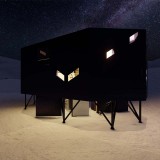This research paper deals with the construction of a residential unit in extreme environmental conditions. Thus, the Antarctic region is chosen, being the driest and coldest desert. Of course, in addition to its inhospitable environment in terms of climatic data, this particular part is also the main "homeostatic mechanism" of the global climate system, making a key contribution to the balance of ecosystems. However, with the rise of CO2 gas emissions in recent decades, this Antarctic mechanism is hindered, causing a number of environmental issues. The study of regulatory factors has been undertaken for years by research stations in this area. After a relevant examination of these, mainly in terms of the structural features and the building program, elements emerged, which I use as tools for the study. The main synthetic principle is water and the changes in its natural state. Thus, from the ground floor level, where the ice is stored, one reaches the first floor, where a water tank is placed, thus producing the phenomenon of melting. Then, on the second floor, the sauna is integrated into the architectural plan of the proposal. In this way, the phenomenon of evaporation is observed. In addition, due to the lack of both vegetation and fresh food, the adoption of vertical hydroponics is chosen, using the waste of the water tank, in which fish thrive. The main circular traffic in the building makes it easy to get out of the research station in case of fire. In addition, the use of a multitude of energy systems and thermal insulation materials serves to further shield the building from very low temperatures. Such an example is the special construction of openings, which absorb CO2 for energy production, thus functioning with a dual role.







